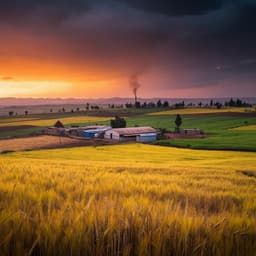
Agriculture
Socioeconomic determinants of farm household land allocation for grass pea production in North Wollo Zone of Amhara region, Ethiopia
S. Damene, D. D. Guta, et al.
Explore the fascinating determinants influencing smallholder farmers' allocation of land to grass pea production in the Ethiopian highlands! This insightful research, conducted by Shimeles Damene, Dawit Diriba Guta, Mohammed Assen, and Poshendra Satyal, reveals key factors such as landholding size and education while addressing the challenges posed by health and farm extension services.
~3 min • Beginner • English
Introduction
The study addresses why smallholder farmers in the Ethiopian highlands allocate land to grass pea despite its known health risks (lathyrism). In Ethiopia, agriculture is central to GDP, employment, and exports, and pulses are major crops, with grass pea significant in the Amhara region. Grass pea remains popular due to its multiple uses, drought and waterlogging tolerance, and low input needs, yet overconsumption is linked to lathyrism, especially in Amhara. Prior research has noted associations between drought, food shortages, and increased grass pea production/consumption, but there is limited empirical evidence on determinants of household land allocation to grass pea. The research question: what socioeconomic and environmental factors influence farmers’ decisions to grow grass pea and the intensity of land allocated to it? Understanding these determinants is important for designing policies to reduce dependence on grass pea and mitigate health impacts.
Literature Review
Existing literature indicates grass pea is cultivated globally (Africa, Asia, Europe, South America) with ~1.5 million ha producing ~1.2 million tons annually, valued for resilience under harsh conditions (drought, waterlogging, heavy clays, frost, pests) and for dual use (food grain and nutritious livestock feed). Despite health risks (lathyrism), it remains important for vulnerable populations, including Ethiopia’s highlands where prevalence has been documented. Determinants of crop land allocation include market access, policies, crop physiology/resilience, inputs, and extension/credit. Socioeconomic factors such as household size, age, dependency, education, income, landholding, credit access, and extension services influence decisions. Education can lower reliance on grass pea through awareness of health risks, while market proximity and perceptions of climate stress can increase cultivation of resilient, cash-oriented crops. However, how these factors jointly shape grass pea land allocation in Ethiopia is underexplored.
Methodology
Design: Mixed-methods approach combining quantitative household survey with qualitative focus group discussions (FGDs) and key informant interviews (KIIs) to triangulate findings.
Study area: Delanta and Dawnt districts, Amhara region, Central Highlands of Ethiopia (11°20′–11°50′N; 38°40′–39°30′E). Diverse topography (1348–3658 m amsl) with plateau and clayey soils (Vertisols) prone to waterlogging; dega agro-ecology is a major grass pea production zone. Population projections (2018): Dawnt ~73,894; Delanta ~137,970.
Sampling and data collection: Purposive selection of the two districts due to high grass pea production and lathyrism prevalence. Multi-stage sampling targeted dega kebeles with plateau landforms and lathyrism prevalence. From 25 dega kebeles, 12 shortlisted via GIS-based terrain analysis; 6 kebeles finally selected (Dawnt: Atsefit-Yekendat, Debir-Agonat; Delanta: Chew-Katir, Kachin-Ara, Baba, Silana-Tikrena). Sample size: 384 households (Cochran formula), proportionally allocated by kebele; randomized household selection with contingency replacements. Quantitative data via semi-structured questionnaires (Amharic/English), pre-tested; qualitative data via 6 FGDs (10–12 diverse participants each) and 13 KIIs (health and ag extension workers, district offices, lathyrism association, affected individuals). Survey covered crop/livestock production for June 2015–May 2016.
Ethics: Approval from Addis Ababa University ethics body; informed consent obtained; confidentiality maintained; 384 completed interviews with 7 refusals respected.
Data processing and analysis: Data cleaned and entered in SPSS; quality checks with 10% raw data cross-verification. Quantitative analysis used descriptive statistics (SPSS) and Heckman two-stage selection model (STATA v16). Qualitative data analyzed thematically to corroborate quantitative results.
Wealth index: Constructed from asset ownership (corrugated iron roof house, ≥2 oxen, ≥2 cows, phone, bicycle/horse/mule, solar/biogas lamp) coded binary, plus proportion of food-sufficient months (scaled 0–1). Wealth score computed as the average of 8 components multiplied by 100.
Econometric model: Heckman selection model to correct for sample selection (first-stage probit for decision to grow grass pea; second-stage outcome for intensity of land allocated conditional on growing). Independent variables included: log income, livestock TLU, landholding size, wealth index (and square), household size, age, gender, education dummies (first cycle primary, second cycle primary, high school), credit access, farm extension access, distance to market (selection only), perceived climate change, and district dummy. Significance assessed via standard errors; model diagnostics included Wald chi-square and correlation of error terms (rho).
Key Findings
- Cultivation prevalence and land shares: 75% (288/384) households grew grass pea in 2015–2016; average allocation from own farmland ~26% (0.232 ha per household, third after wheat 33% and teff 27%). Across own plus shared-in land, households on average cultivated ~0.9 ha with grass pea; some up to >2 ha via sharecropping.
- Crop diversification: Wheat (90%), teff (57%), lentil (47%), chickpea (38%) among common crops.
- Socioeconomic profile: Mean landholding 0.89 ha; 95% male-headed; education: 32% grades 5–8, 15% grades 1–4, 7% grades 9–10, 31% illiterate; credit access 23%; farm extension contact 75%; mean distance to market ~6 km; 82% perceived climate change; wealth ranking: 37.1% very poor, 49.9% poor.
- Heckman model diagnostics: Positive correlation between selection and outcome error terms (rho=0.543); Wald chi2=25.96 (P<0.026); lambda significant at ~10% (P<0.066), indicating selection bias addressed by the model.
- Determinants of intensity (conditional on growing):
• Landholding size: positive and significant (coef ~0.026, p<0.1); +1 ha landholding increases grass pea area by ~0.03 ha.
• Age of household head: positive and significant (coef ~0.002, p<0.05); each additional year increases area by ~0.002 ha.
• Head attended first cycle primary (grades 1–4): positive and significant (coef ~0.041, p<0.1); +0.04 ha vs illiterate.
• Access to farm extension: negative and significant (coef ~-0.041, p<0.05); households with extension allocate ~0.04 ha less.
• Other variables (income, livestock TLU, wealth index, gender, credit) not significant in intensity equation.
- Determinants of decision to grow (selection equation):
• Household size: positive (p<0.01) increases probability of growing.
• Wealth index: positive (p<0.1) increases probability; wealth squared not significant.
• Distance to market: negative (p<0.01); farther households less likely to grow.
• Head high school: negative (p<0.05) lowers probability vs illiterate.
• Perceived climate change (positive but not significant), income, livestock, landholding, gender, credit, farm extension not significant in selection.
- Qualitative insights: Farmers choose grass pea for drought/waterlogging tolerance, high yield on clayey, poorly drained plateau soils, low input and labor needs, and valuable straw for livestock feed. Sharecropping enables larger grass pea areas, often managed by wealthier farmers or those facing labor/time constraints; female-headed households often lease/share out land.
- Health linkage: Increased production and consumption associated with lathyrism cases in the study area.
Discussion
The findings identify key socioeconomic and environmental determinants of land allocation to grass pea, directly addressing the research question. Larger landholders and older household heads allocate more land to grass pea, reflecting resource endowments and labor-saving preferences. Minimal education (primary first cycle) appears to encourage allocation to grass pea, potentially due to market awareness and the crop’s cash attributes, whereas higher education (high school) reduces the likelihood of growing, aligning with increased awareness of health risks and diversification options. Access to agricultural extension significantly reduces intensity, suggesting informational and advisory services effectively encourage crop diversification away from grass pea. Market access shapes participation: proximity increases the likelihood of growing grass pea as a cash crop. Household size increases propensity to grow, likely due to food security pressures and the crop’s resilience to climatic stress. Together, these results underscore the roles of extension, education, market infrastructure, and land endowments in shaping crop choices, offering leverage points for policy to reduce dependence on grass pea and mitigate lathyrism risks while maintaining livelihoods and livestock feed needs.
Conclusion
Grass pea remains widely cultivated in the study area due to its resilience, low input needs, and dual-use benefits, but reliance on it contributes to lathyrism and socioeconomic burdens. The study shows that landholding size, household head age, and primary-level education increase the intensity of land allocation to grass pea, while access to farm extension reduces it; market proximity increases the probability of growing. Policy recommendations include expanding awareness of health risks, enhancing agricultural and health extension services, promoting crop and diet diversification (e.g., pulses like chickpea suitable to local agro-ecologies), improving market access for alternative crops, expanding credit and input availability, strengthening family planning and education, and supporting off-farm income generation. Livestock feed alternatives (forage development and improved breeds/feeding systems) should be promoted to reduce dependence on grass pea straw. Future research should extend the analysis across more districts and over multiple years to capture spatial and temporal dynamics and inform national-level strategies.
Limitations
The study is limited to two adjoining districts in the Amhara region, constraining generalizability across Ethiopia. It relies on cross-sectional data for a single agricultural year (2015–2016), which does not capture temporal variations or long-term trends. Expanding the spatial coverage and employing panel/time-series data are recommended for broader and more robust policy insights.
Related Publications
Explore these studies to deepen your understanding of the subject.







